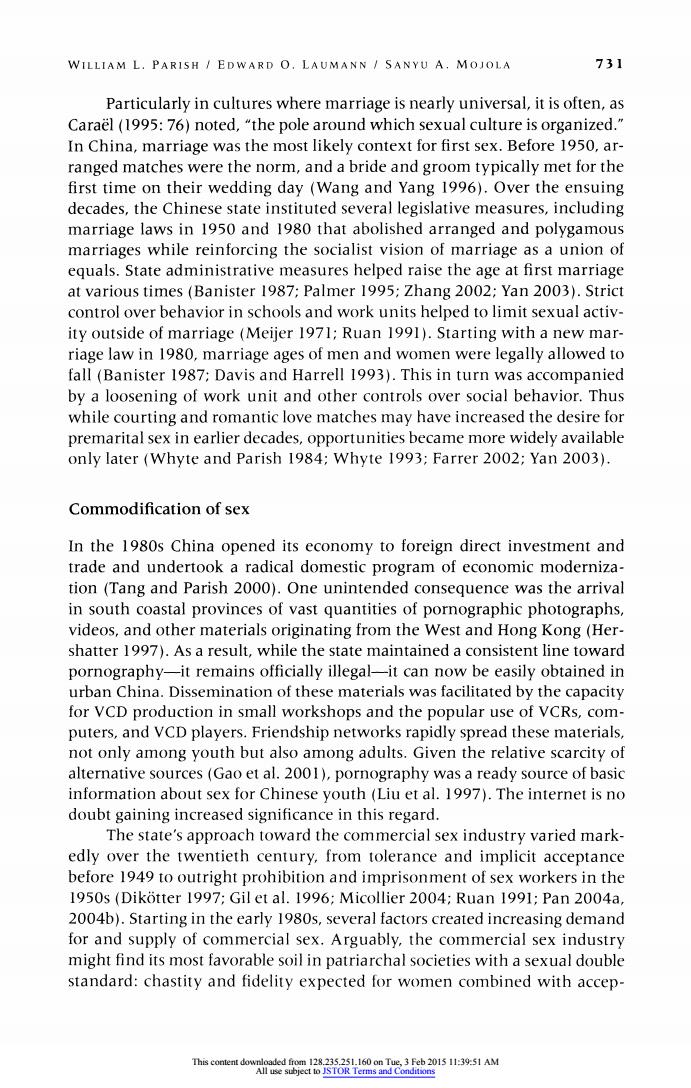正在加载图片...

WILLIAM L.PARISH EDWARD O.LAUMANN SANYU A.MOJOLA 731 Particularly in cultures where marriage is nearly universal,it is often,as Carael (1995:76)noted,"the pole around which sexual culture is organized." In China,marriage was the most likely context for first sex.Before 1950,ar- ranged matches were the norm,and a bride and groom typically met for the first time on their wedding day (Wang and Yang 1996).Over the ensuing decades,the Chinese state instituted several legislative measures,including marriage laws in 1950 and 1980 that abolished arranged and polygamous marriages while reinforcing the socialist vision of marriage as a union of equals.State administrative measures helped raise the age at first marriage at various times (Banister 1987;Palmer 1995;Zhang 2002;Yan 2003).Strict control over behavior in schools and work units helped to limit sexual activ- ity outside of marriage (Meijer 1971;Ruan 1991).Starting with a new mar- riage law in 1980,marriage ages of men and women were legally allowed to fall (Banister 1987;Davis and Harrell 1993).This in turn was accompanied by a loosening of work unit and other controls over social behavior.Thus while courting and romantic love matches may have increased the desire for premarital sex in earlier decades,opportunities became more widely available only later (Whyte and Parish 1984;Whyte 1993;Farrer 2002;Yan 2003). Commodification of sex In the 1980s China opened its economy to foreign direct investment and trade and undertook a radical domestic program of economic moderniza- tion (Tang and Parish 2000).One unintended consequence was the arrival in south coastal provinces of vast quantities of pornographic photographs, videos,and other materials originating from the West and Hong Kong (Her- shatter 1997).As a result,while the state maintained a consistent line toward pornography-it remains officially illegal-it can now be easily obtained in urban China.Dissemination of these materials was facilitated by the capacity for VCD production in small workshops and the popular use of VCRs,com- puters,and VCD players.Friendship networks rapidly spread these materials, not only among youth but also among adults.Given the relative scarcity of alternative sources (Gao et al.2001),pornography was a ready source of basic information about sex for Chinese youth (Liu et al.1997).The internet is no doubt gaining increased significance in this regard. The state's approach toward the commercial sex industry varied mark- edly over the twentieth century,from tolerance and implicit acceptance before 1949 to outright prohibition and imprisonment of sex workers in the 1950s (Dikotter 1997;Gil et al.1996;Micollier 2004;Ruan 1991;Pan 2004a, 2004b).Starting in the early 1980s,several factors created increasing demand for and supply of commercial sex.Arguably,the commercial sex industry might find its most favorable soil in patriarchal societies with a sexual double standard:chastity and fidelity expected for women combined with accep- This content downloaded from 128.235.251.160 on Tue,3 Feb 2015 11:39:51 AM All use subject to JSTOR Terms and ConditionsWilliam L. Parish / Edward O. Laumann / Sanyu A. Mojola 731 Particularly in cultures where marriage is nearly universal, it is often, as Carael (1995: 76) noted, "the pole around which sexual culture is organized." In China, marriage was the most likely context for first sex. Before 1950, ar ranged matches were the norm, and a bride and groom typically met for the first time on their wedding day (Wang and Yang 1996). Over the ensuing decades, the Chinese state instituted several legislative measures, including marriage laws in 1950 and 1980 that abolished arranged and polygamous marriages while reinforcing the socialist vision of marriage as a union of equals. State administrative measures helped raise the age at first marriage at various times (Banister 1987; Palmer 1995; Zhang 2002; Yan 2003). Strict control over behavior in schools and work units helped to limit sexual activ ity outside of marriage (Meijer 1971; Ruan 1991). Starting with a new mar riage law in 1980, marriage ages of men and women were legally allowed to fall (Banister 1987; Davis and Harrell 1993). This in turn was accompanied by a loosening of work unit and other controls over social behavior. Thus while courting and romantic love matches may have increased the desire for premarital sex in earlier decades, opportunities became more widely available only later (Whyte and Parish 1984; Whyte 1993; Farrer 2002; Yan 2003). Commodification of sex In the 1980s China opened its economy to foreign direct investment and trade and undertook a radical domestic program of economic moderniza tion (Tang and Parish 2000). One unintended consequence was the arrival in south coastal provinces of vast quantities of pornographic photographs, videos, and other materials originating from the West and Hong Kong (Her shatter 1997). As a result, while the state maintained a consistent line toward pornography?it remains officially illegal?it can now be easily obtained in urban China. Dissemination of these materials was facilitated by the capacity for VCD production in small workshops and the popular use of VCRs, com puters, and VCD players. Friendship networks rapidly spread these materials, not only among youth but also among adults. Given the relative scarcity of alternative sources (Gao et al. 2001), pornography was a ready source of basic information about sex for Chinese youth (Liu et al. 1997). The internet is no doubt gaining increased significance in this regard. The state's approach toward the commercial sex industry varied mark edly over the twentieth century, from tolerance and implicit acceptance before 1949 to outright prohibition and imprisonment of sex workers in the 1950s (Dikotter 1997; Gil et al. 1996; Micollier 2004; Ruan 1991; Pan 2004a, 2004b). Starting in the early 1980s, several factors created increasing demand for and supply of commercial sex. Arguably, the commercial sex industry might find its most favorable soil in patriarchal societies with a sexual double standard: chastity and fidelity expected for women combined with accep This content downloaded from 128.235.251.160 on Tue, 3 Feb 2015 11:39:51 AM All use subject to JSTOR Terms and Conditions